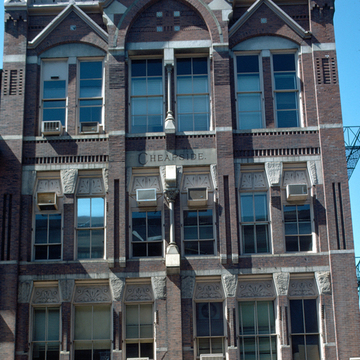At 27 North Main is RISD's “Bank Building” (
PR55.1), formerly People's Savings Bank (1913, Clarke and Howe), studio space converted from a typical early-twentieth-century banking hall fronted by a monumental twocolumned Ionic portico. Just beyond and opposite are two Victorian commercial buildings, the Hope Block, at numbers 22–26 (
PR55.2; 1869) and Cheapside, at number 28 (
PR55.3; 1880, Stone and Carpenter), one mansarded Second Empire style, the other Victorian Gothic, both with fine cast iron storefronts. These two buildings and two earlier twentieth-century office buildings in the late 1920s Neo-Federal mode are now linked for RISD store, gallery, classroom, and office use in a sensitive and ingenious 1980s remodeling by Gordon Washburn, which merits study. Of the Canal Street Row, the Insurance Building, at 31 Canal Street (
PR55.4; 1929, Clarke and Howe) is worth notice for nice detailing at the street
Across the street, at 29 North Main, the south half of the decorated reinforced concrete–framed building in the monumentalized factory style of the early twentieth century houses RISD's textile design studios ( PR55.6; 1915, Charles Klauder). Named for Jesse Metcalf, the building fittingly memorializes the founder of the Wanskuck Company, one of Providence's principal textile concerns during the late nineteenth and early twentieth centuries. It was the gift of a family which, through three generations, contributed virtually all of RISD's buildings and gave much other support as well. The identical northern half, added five years later, provided for jewelry design and metalwork. When completed, the building therefore represented Rhode Island's three principal “art design industries,” as they were called in the nineteenth century. Its completion also fulfilled, with proper quarters and equipment, a primary objective of the school's founding, which had been to provide designers in the decorative arts for regional industries. The Jesse Metcalf Building strikes a nice balance between severe functionalism and just enough concern for proportion, fine brick craftsmanship, and spare Renaissance ornament to suggest a monumentality appropriate for an academic building—somewhat marred, however, by replacements for the original standard metal industrial sash.














